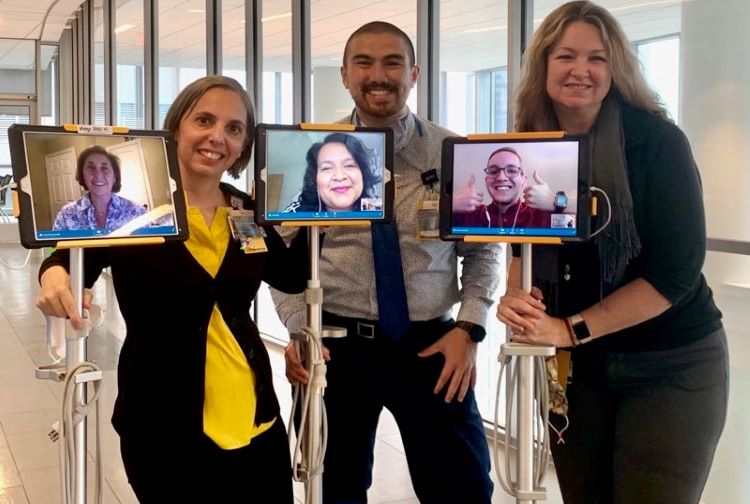
Interpreters and translators expand services during COVID-19 at VCU Medical Center
July 14, 2020
Story contributed by the Wright Center for Clinical and Translational Research
Pictured above: The VCU Health medical language services team – in person and virtual. From left to right: Pilar Garcia, Clara Dutari, Liliana Valladares, Evan Lee-Ferrand, David Eddington and Jen Ayala.
Latinos hit especially hard by coronavirus
Clara Dutari is bilingual, interpreting for Spanish-speaking patients at VCU Health. But she doesn’t just convert words, like a Spanish-English dictionary. She provides context, nuance and intuition to improve communication.
One of six interpreters and translators at VCU Medical Center, Dutari sometimes sees patients nodding as their doctor speaks, but she can tell just by looking that the patients don’t understand. She questions their comprehension and fills in the gaps. On the other side of the coin, when interpreting from Spanish to English, Dutari inserts any cultural nuance reflected in the patients’ dialect to ensure their doctor’s complete understanding.
More Spanish speakers seeking care due to COVID-19
With COVID-19 disproportionately affecting the Latinx community, more Spanish speakers with limited English are seeking care at VCU Health. At the same time, visitor restrictions have limited their ability to bring English-speaking friends or relatives with them. VCU Health interpreters and translators are working longer workdays to assist VCU Health’s increasing number of Spanish-speaking patients.
Interpreters now average four to six hours a day of non-stop interpreting, accompanying patients through their health care journey. VCU Health’s full-time translator averages 45 to 60 documents a month, with each document anywhere between 80 to 200 pages.
Access to care includes language services
Evan Lee-Ferrand, medical interpreter supervisor at VCU Health, oversees the team of six full-time employees: two Spanish-language interpreters, one Spanish-language translator, an office coordinator and one sign language interpreter. Another 13 freelance interpreters are available for more Spanish help and other languages, like Arabic, Chinese and Vietnamese.
“Translating and interpreting are a different set of skills,” says Lee-Ferrand. “When it's the written word, we're very loyal to written word. In interpreting, there's colloquialism — slang and context. It's not word for word. It's concept by concept.”
Both are crucial to supporting the patient experience at VCU Health, especially for the Spanish-speaking Latinx community that makes up 6.7 percent of Richmond’s population. Access to care means access to trained, certified, medical interpreters and translators.
“A lot of people take for granted how much more authentic conversations are because of using an interpreter,” says Lee-Ferrand. “We're highly skilled in things like memory, pacing and simultaneous cognitive processes, where you’re listening and interpreting at the same time.”
Interpreters train for the challenges of being present during a sensitive situation. Lee-Ferrand recalls interpreting at an eastern Virginia clinic where a family member had been interpreting for a patient. The family member was unhappy when Lee-Ferrand showed up to provide support.
“The family member left, and the patient turns to me and says, ‘For the first time in seven years, I know every single word the doctor is telling me,’” Lee-Ferrand said. “’And I know for once the doctor can hear every single word I'm saying.’”
One word ill-defined can have major consequences
With a new virus, there are many unknowns, and patients need to understand the risks and benefits of every decision they must make. Patients must feel confident they’re getting accurate, unfiltered information. This puts extra pressure on interpreters, who know their words can have a major impact on patient decisions.
Interpreters use their knowledge and experience with culturally based medical practices to bridge gaps during medical history taking. They must also interpret a variety of dialects – words that might translate one way officially but carry rich cultural context within a particular community.
“Any time we see a cultural difference in language or grammar that poses a language barrier, we make sure that the full picture is translated,” Lee-Ferrand says.
New challenges — and opportunities — with COVID-19
Medical interpreters have experienced both challenges and opportunities with COVID-19. On the one hand, in-person interpreting is more important than ever. Hospitalized patients, who might ordinarily have a family member on hand to help, are now quarantined alone. And survivors of COVID-19 need to understand the importance of quarantine and other cautions when discharged.
On the other hand, on-site interpreting exposes interpreters to possible infection. Live video technology has allowed interpreters to connect with patients remotely through high-definition TVs in patient rooms.
“COVID pushed our department to cover more, to provide more services, including to hospitalized patients,” says Dutari.
Now Dutari and her colleague David Eddington cover inpatient interpreting full time, and the department is hiring another interpreter to cover the outpatient work that previously took up most of their case load.
“As interpreters, we are there all the time,” Dutari says. “We interpret for the nurses, the residents, the pharmacists. Since we are in all those encounters, we are able to make sure all the information is available.”
Expanded services promotes diversity in clinical trials
The language services team also makes it possible for non-English speakers to join COVID-19 clinical trials.
Clinical trials give patients choices, especially important in the midst of a new virus with few approved treatments. If there are no interpreters and translators to ensure that a non-English-speaking patient understands the risks and benefits of a trial, the patient doesn’t have this option.
Translators like Pilar Garcia bring that option to Latinx patients by translating pages of important documents, such as consent forms and discharge instructions. And interpreters like Dutari ensure that clinical trial investigators and patients are on the same page – literally and figuratively.
“The participation of diverse populations improves the reliability of study results and the health advancement that clinical trials bring to all patient care,” says Antonio Abbate, M.D., Ph.D., who oversees multiple trials at VCU Health. “The interpreters and translators are essential to our ability to expand access to the trials. They’ve really gone above and beyond during the pandemic.”
As an associate director at the C. Kenneth and Dianne Wright Center for Clinical and Translational Research, Abbate is part of a committee that evaluates and prioritizes potential drug treatments for COVID-19 and is the principal investigator of one of the clinical trials.
“It’s especially vital to get everything right when you interpret and translate for trials,” says Dutari. “We're not merely repeating. We work closely with the study team to convey the appropriate message and work as a team. I think it makes the team better.”
The Wright Center informatics team, which helps clinical trials study teams manage data, reports that 13 percent of COVID-19 clinical trials participants identify as Hispanic or Latinx — some of whom are Spanish speakers or of limited-English proficiency.
Dutari says most patients immediately grasp the importance of participation — not just for themselves but for the scientific knowledge that the trials will bring to all patients affected by COVID-19.
Despite the increased pressures, workload and risk of working on the frontline, members of the medical interpreter and translation team enjoy their job.
“It's been every day something new,” says Dutari. “I love the challenge and the creativity it brings out of us. The whole team has such a great passion for helping patients, and that's what drives us the most.”


.ashx)
